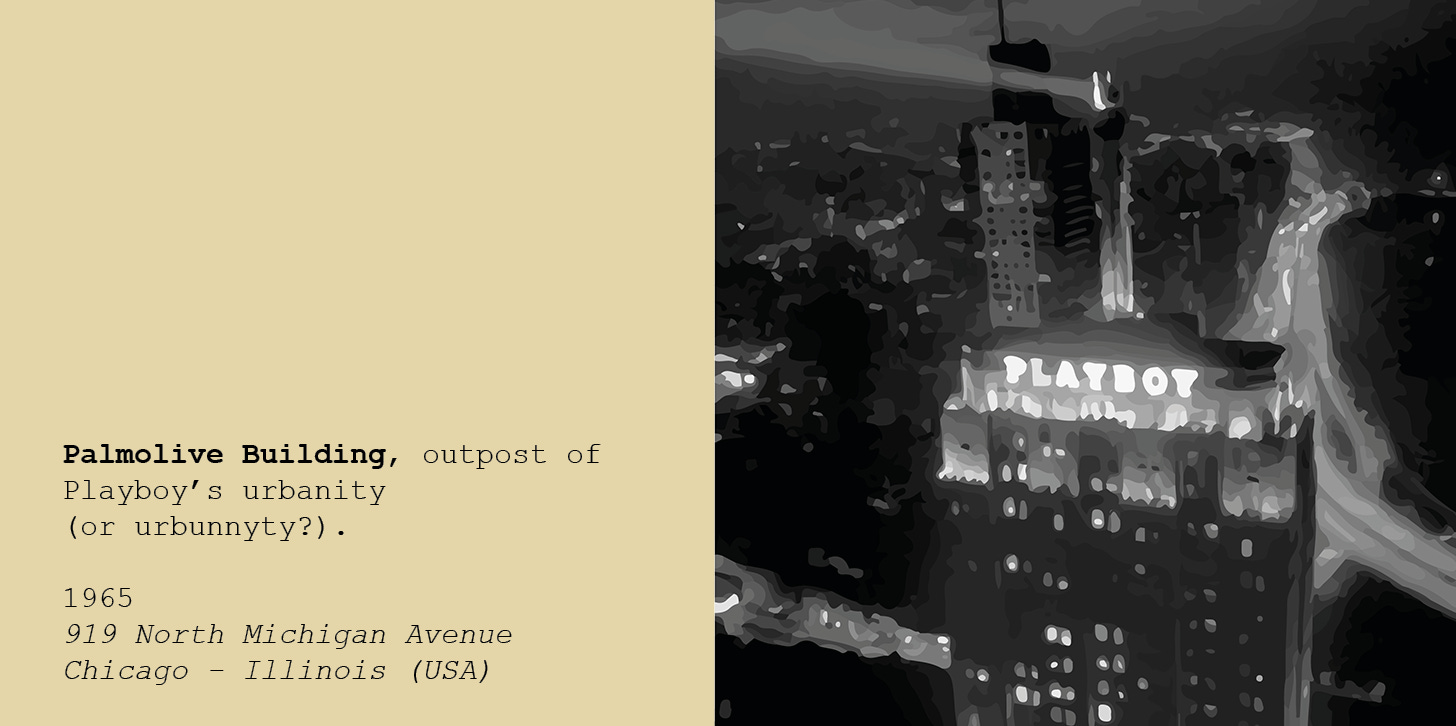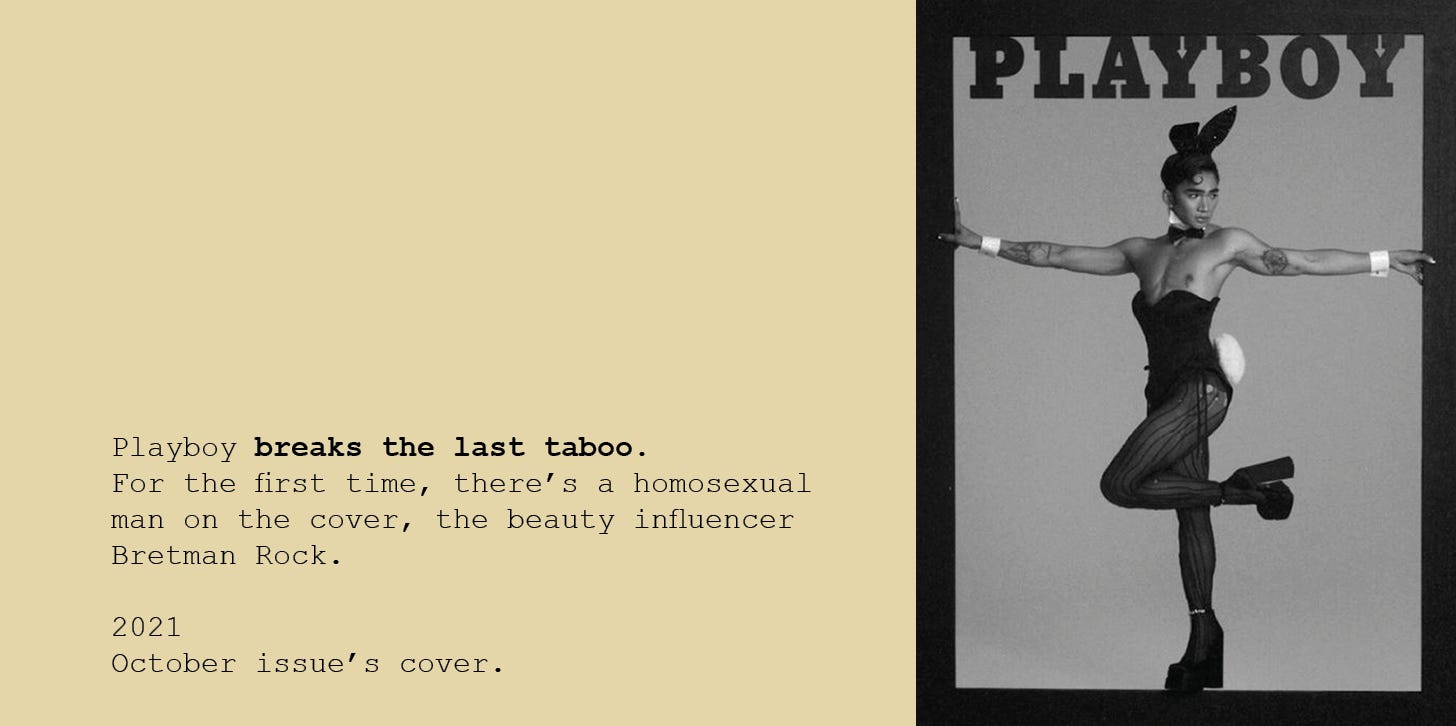In Luisa's salon, a refined hairdresser who mixes the tools of the trade with design objects, new trends and pieces of furniture, there’s a pile of Playboy. Flipping through it - for the first time in my life, I admit it- I find myself immersed in a world that’s very different from the one I had imagined. The pages, which I believed were full of naked girls with bunny ears, are mostly occupied by articles on lifestyle, urban innovation and politics, and the few nudes, both female and male, are closer to art than to pornography. If it weren't for the rabbit with a bow tie on the cover and for the stereotypes it carries with it, Playboy could easily be a news magazine focused on architecture, design and the city .
This reflection brings out a memory that I focus on among the shelves of the library. In 2010, Paul B. Preciado, Spanish writer and philosopher, published “Pornotópia. Arquitectura y sexualidade en “Playboy” durante la guerra fría”, translated into English in 2014 in “Pornotopia: An Essay on Playboy’s Architecture and Biopolitics” (Zone Books).
Pornotopia: An Essay on Playboy’s Architecture and Biopolitics
1st of March 2022
reading time: 5’ 40’’
Paraphrasing the beginning of the book:
This project was born from a sleepless night. I was watching television while trying to sleep in my Brooklyn apartment when, suddenly, I overheard Hugh Hefner, the Playboy director, in his pajamas, robe and slippers, talking about the importance of architecture in the empire that he himself had created…
The research earned Preciado a PhD in Philosophy and Theory of Architecture at Princeton (New Jersey, USA) and reveals the architectural and media value of the Playboy phenomenon, a revolution in the customs of American society that began with the diffusion through the press of a new way of living and narrating the space.
Started in 1953 with very few expectations (its founder didn’t even believe he could publish the second issue), Playboy became a platform for the diffusion of architecture and design as primary consumer goods of the new American popular culture. But that's not all. Indeed, the magazine offers an alternative to the traditional American family unit which identifies itself with a new domesticity, suddenly spectacularized; the boundary between public and private is mixed and the transformation of architecture begins, through the means of communication, and has continued since the second half of the twentieth century.
The word "Play-boy" itself has a very explicit meaning: during obscurantism and in opposition to the rationalism of International Style, already popular for twenty years, Hefner proposes a diametrically opposite lifestyle based on the game, on crossing of borders and limits, on a way of living the house and the space that is more relaxed, fluid, idle, even theatrical. What does the house have to do with it? Everything! Because as Playboy's founder himself stated:
if you want to change a man, change his house!
which could be translated as "we are the places we live", or through the philosophical thinking of Preciado: “Subjectivity is not accessed through a psychological narrative but through architectural representation”.
American population appreciate Hefner's proposal so much, and even architects and urban planners start to discover the inside of the apartments and unveil the existence of a map of the city, overlapping the legal one, in which "the gambling and sex industries draw their own roads".
So while Mies van der Rohe “empty” architecture by eliminating the interior walls and any decoration, Hefner insists on exposing domesticity, revealing the theatrical and political character of architecture which considers the inhabitants as its own actors and spectators. The absolute protagonist is a bachelor living in a penthouse surrounded by technical devices (that’s the era of the household appliances), with fluid and interchangeable spaces, suitable for welcoming guests and playmates every day. What role does the woman play? Represented as "the girl next door", she gets rid of the role of “housewife” thanks to the appliances that allow her to have more time to dedicate to the art of pleasure and seduction, but ib so doing, the woman is, to be honest, “replaced” and also supplanted by the house, her reign since forever, to become a passive spectator of masculinity. Playboy, in fact, contributes to spreading that heterosexual and patriarchal imagery which has always gone hand in hand with capitalism which equates power-money-pleasure and which has shaped entire generations of men, women and places.
In a little less than ten years Playboy also colonized the city. The process began in Chicago in 1960 where the first clubs with a "modern design" were born, which, by disguising the forms of the brothel, opened the doors to managers and professionals of the upper-middle class and no longer just to rigid members of Masonic societies. The process culminates when in 1965 Hefner buys the 37-floor skyscraper known as "Palmolive Building".
This is how the magazine was transformed into a place, indeed an archipelago of temples of hedonism, psychedelia and popular culture that colonize the mind of Americans and their cities, giving rise to the phenomenon that Preciado defines as Pornotopia1: a set of spaces, public and private, where sexuality and pleasure can be dramatized according to laws, codes and behaviors that are usually invisible in urban cartography, yet protagonists of the landscape. Every city, both in the past and in the present, has a sexual topography that tends to mask, made of those places that daily welcome, more or less consciously, performances that have to do with gender, body practices, rituals of pleasure production. Just think of the advertising posters or the recent street-protests for gender equality that literally fill public space.
Now, Playboy is an empire in crisis. The last paper issue was released in March 2020 and yet many of its transformations survive precisely in phenomena that seem to have come to life from Hefner's intuitions: just think of the extreme spectacularization of intimacy which led to the phenomenon of reality TV (first of all Big Brother) or, as Preciado writes “to the myth of masculinity that survives in the videos of the hip-hoppers who, to face the threats of female liberation and transgender utopia, continue to show the woman as an object, now no longer domestic but urban".
It seems that for a few more years we will continue to inhabit pornotopia, perhaps until a new home suggests what kind of men and women to be, hoping that by then gender equality will be the norm.
If you’ve read this far… THANK YOU!
If you liked this post, why not share it?
and if you have any comments or suggestions, write us!
See you for the next Postcard!
Pornotopia was born from the concept of heterotopia coined by Foucalt in 1967. Heterotopia is a set of “other” spaces, in which the legal norm that rules in every other place is suspended, as in a sort of “localized utopias”, which find a temporary space of expression.










